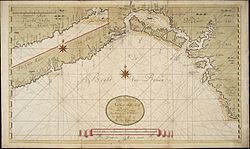
Back شاطئ العبيد الهولندي Arabic Mariña de los Esclavos Neerlandesa AST Costa de los Esclavos neerlandesa Spanish Slavekust Frisian Costa degli Schiavi olandese Italian Slavenkust Dutch Нидерландский Невольничий Берег Russian Nizozemska obala sužnjev Slovenian
| Part of a series on |
| Forced labour and slavery |
|---|
 |
Dutch Slave Coast Slavenkust | |
|---|---|
| 1660–1760 | |
 The Slave Coast around 1716. | |
| Status | Dutch colony |
| Capital | Offra (1660–1691) Ouidah (1691–1724) Jaquim (1726–1734) |
| Common languages | Dutch |
| Religion | Dutch Reformed |
| Governor | |
| History | |
• Established | 1660 |
• Disestablished | 1760 |
The Dutch Slave Coast (Dutch: Slavenkust) refers to the trading posts of the Dutch West India Company on the Slave Coast, which lie in contemporary Ghana, Benin, Togo, and Nigeria. The primary purpose of the trading post was to supply slaves for the Dutch colonies in the Americas. Dutch involvement on the Slave Coast started with the establishment of a trading post in Offra in 1660. Later, trade shifted to Ouidah, where the English and French also had a trading post. Political unrest caused the Dutch to abandon their trading post at Ouidah in 1725, now moving to Jaquim, at which place they built Fort Zeelandia. By 1760, the Dutch had abandoned their last trading post in the region.
The Slave Coast was settled from the Dutch Gold Coast, on which the Dutch were based in Elmina. During its existence, the Slave Coast held a close relationship to that colony.

